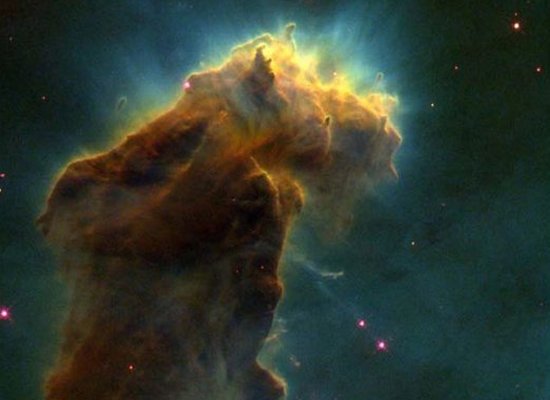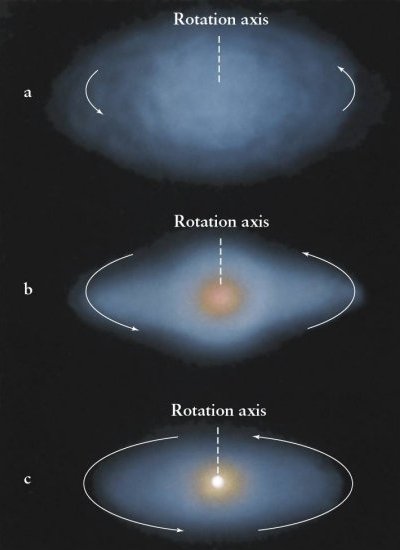Physical Characteristics
Earth, our home, is the third planet from the sun. It is the
only planet known to have an atmosphere containing free oxygen, oceans of liquid water on its surface, and, of course, life.
Earth is the fifth largest of the planets in the solar system — smaller than the four gas giants,
Jupiter,
Saturn,
Uranus and
Neptune, but larger than the three other rocky planets,
Mercury,
Mars and
Venus. It has a diameter of roughly 8,000 miles (13,000 kilometers), and is round because
gravity pulls matter into a ball,
although it is not perfectly round, instead being more of an "oblate
spheroid" whose spin causes it to be squashed at its poles and swollen
at the equator.
Roughly 71 percent of Earth's surface is
covered by water, most of it in the oceans. About a fifth of its atmosphere is made up of oxygen, produced by plants.
Earth's climate has enabled life to evolve on our planet. Life, in turn, has had effects on the climate.
CREDIT: Reto Stöckli, Nazmi El Saleous, and Marit Jentoft-Nilsen, NASA GSFC
Earth's climate has enabled life to evolve on our planet. Life, in turn, has had effects on the climate.
CREDIT: Reto Stöckli, Nazmi El Saleous, and Marit Jentoft-Nilsen, NASA GSFC
Earth's climate has enabled life to evolve on our planet. Life, in turn, has had effects on the climate.
CREDIT: Reto Stöckli, Nazmi El Saleous, and Marit Jentoft-Nilsen, NASA GSFC
Orbital Characteristics
The Earth spins on an imaginary line called an axis that runs from the
north pole to the south pole, while also orbiting the sun. It takes
Earth 24 hours to complete a rotation on its axis, and roughly 365 days
to complete an orbit around the sun.
The Earth's axis of rotation is tilted in relation to the ecliptic
plane, an imaginary surface through Earth's orbit around the sun. This
means the northern and southern hemispheres will sometimes point toward
or away from the sun depending on the time of year, varying the amount
of light they receive and
causing the seasons.
Earth's orbit is not a perfect circle, but is rather an oval-shaped
ellipse, like that of the orbits of all the other planets. Earth is a
bit closer to the sun in early January and farther away in July,
although this variation has a
much smaller effect than the heating and cooling caused by the tilt of Earth's axis. Earth happens to lie within the so-called "
Goldilocks zone" around its star, where temperatures are just right to maintain liquid water on its surface.
History
Earth probably formed at roughly the same time as the sun and other planets
some 4.6 billion years ago, when the solar system coalesced from a giant, rotating cloud of gas and dust known as
the solar nebula.
As the nebula collapsed because of its gravity, it spun faster and
flattened into a disk. Most of the material was pulled toward the center
to form the sun. Other particles within the disk collided and stuck
together to form ever-larger bodies, including the Earth. The solar wind
from the sun was so powerful that it swept away most of the lighter
elements, such as hydrogen and helium, from the innermost worlds,
rendering Earth and its siblings into small, rocky planets.
Scientists think Earth started off as a
waterless mass of rock.
Radioactive materials in the rock and increasing pressure deep within
the Earth generated enough heat to melt Earth's interior, causing some
chemicals to rise to the surface and form water, while others became the
gases of the atmosphere. Recent evidence suggests that Earth's crust
and oceans may have formed within about 200 million years after the
planet had taken shape.
The history of Earth is divided into
four eons
— starting with the earliest, these are the Hadean, Archean,
Proterozoic, and Phanerozoic. The first three eons, which together
lasted nearly 4 billion years, are together known as the Precambrian.
Evidence for life has bee found in the Archaean about 3.8 billion years
ago, but life did not become abundant until the Phanerozoic.
The Phanerozoic is divided into
three eras
— starting with the earliest, these are the Paleozoic, Mesozoic, and
Cenozoic. The Paleozoic Era saw the development of many kinds of animals
and plants in the seas and on land, the Mesozoic Era was the age of
dinosaurs, and the Cenozoic Era we are in currently is the age of
mammals.
Most of the fossils seen in Paleozoic rocks are invertebrate animals
lacking backbones, such as corals, mollusks and trilobites. Fish are
first found about 450 million years ago, while amphibians appear roughly
380 million years ago. By 300 million years ago, large forests and
swamps covered the land, and the
earliest fossils of reptiles appear during this period as well.
The Mesozoic saw the
ascendence of dinosaurs,
although mammals also appear in the fossil record about 200 million
years ago. During this time, flowering plants became the dominant plant
group and continue to be so today.
The Cenozoic began about 65 million years ago with the end of the age
of dinosaurs, which many scientists think was caused by a
cosmic impact. Mammals survived to become the dominant land animals of today.
Composition & Structure
The atmosphere
is roughly
78 percent nitrogen, 21 percent oxygen, with trace amounts of water,
argon, carbon dioxide and other gases. Nowhere else in the solar system
can one find an atmosphere loaded with free oxygen, which ultimately
proved vital to one of the other unique features of Earth — us.
Air surrounds Earth and becomes thinner farther from the surface.
Roughly 100 miles (160 kilometers) above Earth, the air is so thin that
satellites can
zip through with little resistance. Still, traces of atmosphere can be found as high as 370 miles (600 kilometers) above the surface.
The lowest layer of the atmosphere is known as
the troposphere,
which is constantly in motion, causing the weather. Sunlight heats the
Earth's surface, causing warm air to rise. This air ultimately expands
and cools as air pressure decreases, and because this cool air is denser
than its surroundings, it then sinks, only to get warmed by the Earth
once again.
Above the troposphere, some 30 miles (48 kilometers) above the Earth's
surface, is the stratosphere. The still air of the stratosphere contains
the ozone layer,
which was created when ultraviolet light caused trios of oxygen atoms
to bind together into ozone molecules. Ozone prevents most of the sun's
harmful ultraviolet radiation from reaching Earth's surface.
Water vapor, carbon dioxide and other gases in the atmosphere trap heat from the sun, warming Earth. Without this so-called "
greenhouse effect,"
Earth would probably be too cold for life to exist, although a runaway
greenhouse effect led to the hellish conditions now seen on Venus.
Earth-orbiting satellites have shown that the upper atmosphere actually
expands during the day and contracts at night due to heating and cooling.
The Earth's magnetic field is generated by
currents flowing in Earth's outer core. The magnetic poles are
always on the move,
with the magnetic north pole recently accelerating its northward motion
to 24 miles (40 km) annually, likely exiting North America and reaching
Siberia in a few decades.
Earth's magnetic field is changing in other ways, too — globally, the magnetic field has weakened
10 percent since the 19th century.
These changes are mild compared to what Earth's magnetic field has done
in the past — sometimes the field completely flips, with the north and
the south poles swapping places.
When charged particles from the sun get trapped in Earth's magnetic
field, they smash into air molecules above the magnetic poles, causing
them to glow, a phenomenon known as the
aurorae, the northern and southern lights.
Oxygen is
the most abundant element in rocks in Earth's crust,
composing roughly 47 percent of the weight of all rock. The second most
abundant element is silicon at 27 percent, followed by aluminum at 8
percent, iron at 5 percent, calcium at 4 percent, and sodium, potassium,
and magnesium at about 2 percent each.
The Earth's core consists
mostly of iron and nickel
and potentially smaller amounts of lighter elements such as sulfur and
oxygen. The mantle is made of iron and magnesium-rich silicate rocks.
(The combination of silicon and oxygen is known as silica, and minerals
that contain silica are known as silicate minerals.)
The Earth's core is about 4,400 miles (7,100 kilometers) wide,
slightly larger than half the Earth's diameter
and roughly the size of Mars. The outermost 1,400 miles (2,250
kilometers) of the core are liquid, while the inner core — about
four-fifths as big as Earth's moon at some 1,600 miles (2,600
kilometers) in diameter — is solid.
Above the core is
Earth's mantle,
which is about 1,800 miles (2,900 kilometers) thick. The mantle is not
completely stiff, but can flow slowly. Earth's crust floats on the
mantle much as a wood floats on water, and the slow motion of rock in
the mantle shuffles continents around and causes earthquakes, volcanoes,
and the formation of mountain ranges.
Above the mantle, Earth has
two kinds of crust.
The dry land of the continents consists mostly of granite and other
light silicate minerals, while the ocean floors are made up mostly of a
dark, dense volcanic rock called basalt. Continental crust averages some
25 miles (40 kilometers) thick, although it can be thinner or thicker
in some areas. Oceanic crust is usually only about 5 miles (8
kilometers) thick. Water fills in low areas of the basalt crust to form
the world's oceans. Earth has more than enough water to completely fill
the ocean basins, and the rest of it spreads onto edges of the
continents, areas known as the continental shelf.
Earth gets warmer toward its core. At the bottom of the continental
crust, temperatures reach about 1,800 degrees F (1,000 degrees C),
increasing about 3 degrees F per mile (1 degrees C per kilometer) below
the crust. Geologists think the temperature of Earth's outer core is
about 6,700 to 7,800 degrees F (3,700 to 4,300 degrees C), and the inner
core may reach 12,600 degrees F (7,000 degrees C), hotter than the
surface of the sun. Only the enormous pressures found at the super-hot
inner core keep it solid.
Orbit & Rotation
Average Distance from the Sun
English: 92,955,820 miles
Metric: 149,597,890 km
Perihelion (closest)
English: 91,400,000 miles
Metric: 147,100,000 km
Aphelion (farthest)
English: 94,500,000 miles
Metric: 152,100,000 km
Average Length of Solar Day
24 hours
Length of Year
365.24 Earth days
Equatorial Inclination to Orbit
23.45 degrees
(Source:
NASA.)
Moon
Earth's moon is 2,159 miles (3,474 kilometers) wide, about
one-fourth of Earth's diameter. Earth has one moon, while Mercury and Venus have none and all the other planets in our solar system have two or more.
The leading explanation for how the moon formed was that
a giant impact
knocked off the raw ingredients for the moon off the primitive molten
Earth and into orbit. Scientists have suggested the impactor was roughly
10 percent the mass of Earth,
about the size of Mars.
Species Overview
Earth is the
only planet in the universe known to possess life.
There are several million known species of life, ranging from the
bottom of the deepest ocean to a few miles into the atmosphere, and
scientists think far more remain to be discovered.
































